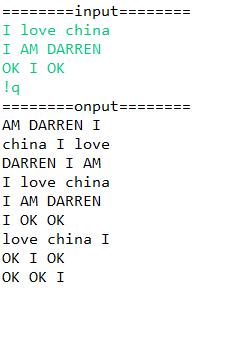130242014034-林偉領-第3次實驗
一、實驗目的
1.理解不同體系結構風格的具體內涵。
2.學習體系結構風格的具體實踐。
二、實驗環境
硬件: (依據具體情況填寫)
軟件:Java或任何一種自己熟悉的語言
三、實驗內容
“上下文關鍵字”KWIC(Key Word in Context,文本中的關鍵字)檢索系統接受有序的行集合:每一行是單詞的有序集合;每一個單詞又是字母的有序集合。通過重復地刪除航中第一個單詞,並把它插入行尾,每一行可以被“循環地移動”。KWIC檢索系統以字母表的順序輸出一個所有行循環移動的列表。
嘗試用不同的策略實現這個系統。選擇2-3種體系結構風格來實現。
四、實驗步驟:
采用主/子程序的風格
1、體系結構圖:

2、簡述體系結構各部件的主要功能,實現思想。
上述的主程序/子程序的方法,將問題分解為輸入(Input)、循環移動(Circular Shifter)、按字母表排序(Alphabetizer)、輸出(Output)。
Input: 將讀取到的每行的數據保存到inList
Circular Shifter:主函數調用該方法,該方法對characters中的每行的數據進行循環移位,並將移位得到的新行保存到outList
alphabetizer: 對circularShift中得到的行數據outList進行按字母順序排序
Output:output方法遍歷輸出經過alphabetizer方法處理後的outList
3、寫出主要的代碼
1 import java.util.ArrayList; 2 import java.util.List; 3 import java.util.Scanner; 4 5 /** 6 * KWIC(Key Word in Context,文本中的關鍵字) 7 * 采用主/子程序風格 8 * @author L 9 * 10 */ 11 public class KWIC { 12 13 private List<String[]> inList = new ArrayList<String[]>(); 14 privateList<String[]> outList = new ArrayList<String[]>(); 15 public static void main(String[] args) { 16 KWIC test = new KWIC(); 17 test.input(); 18 test.CircularShifter(); 19 test.Alphabetizer(); 20 test.output(); 21 } 22 /** 23 * 輸入 24 */ 25 private void input() { 26 Scanner scanner = new Scanner(System.in); 27 System.out.println("========input========"); 28 while (true) { 29 String temp; 30 temp = scanner.nextLine(); 31 if (!temp.equals("!q")) { 32 inList.add(temp.split(" ")); 33 } 34 else{ 35 break; 36 } 37 } 38 } 39 /** 40 * 循環位移 41 */ 42 private void CircularShifter() { 43 ArrayList<String[]> tempList = new ArrayList<String[]>(); 44 tempList.addAll(inList); 45 String temp; 46 for (int i = 0; i < tempList.size(); i++) { 47 for (int j = 0;j < tempList.get(i).length; j++) { 48 outList.add(tempList.get(i).clone()); 49 temp = tempList.get(i)[0]; 50 for (int k = 0;k < tempList.get(i).length-1; k++) { 51 tempList.get(i)[k] = tempList.get(i)[k+1]; 52 if(k == tempList.get(i).length-2){ 53 54 tempList.get(i)[tempList.get(i).length-1]=temp; 55 } 56 } 57 } 58 } 59 } 60 /** 61 * 按字母表順序排序 62 */ 63 private void Alphabetizer(){ 64 String[] temp; 65 for(int i = 0;i<outList.size();i++){ 66 for(int j = i;j<outList.size()-1;j++){ 67 if(outList.get(i)[0].toLowerCase().charAt(0)>outList.get(j+1)[0].toLowerCase().charAt(0)){ 68 temp = outList.get(i); 69 outList.set(i, outList.get(j+1)); 70 outList.set(j+1, temp); 71 } 72 } 73 } 74 } 75 /** 76 * 輸出 77 */ 78 private void output(){ 79 System.out.println("========onput========"); 80 for(int i = 0;i<outList.size();i++){ 81 for (int j = 0;j<outList.get(i).length;j++){ 82 System.out.print(outList.get(i)[j]+" "); 83 } 84 System.out.println(""); 85 } 86 } 87 }
采用管道過濾器風格
1、體系結構圖:

2、簡述體系結構各部件的主要功能,實現思想。
上述的管道過濾器的方法,將問題分解為輸入(Input)、循環移動(Circular Shifter)、按字母表排序(Alphabetizer)、輸出(Output)。
Input: 將讀取到的每行的數據保存到inList,調用Circular Shifter方法
Circular Shifter:主函數調用該方法,該方法對characters中的每行的數據進行循環移位,並將移位得到的新行保存到outList,調用alphabetizer方法
alphabetizer: 對circularShift中得到的行數據outList進行按字母順序排序,調用Output方法
Output:output方法遍歷輸出經過alphabetizer方法處理後的outList
3、寫出主要的代碼
1 import java.util.ArrayList; 2 import java.util.List; 3 import java.util.Scanner; 4 5 /** 6 * KWIC(Key Word in Context,文本中的關鍵字) 7 * 采用管道過濾器風格 8 * @author L 9 * 10 */ 11 public class KWIC2 { 12 13 private List<String[]> inList = new ArrayList<String[]>(); 14 private List<String[]> outList = new ArrayList<String[]>(); 15 public static void main(String[] args) { 16 KWIC2 test = new KWIC2(); 17 test.input(); 18 } 19 private void input() { 20 Scanner scanner = new Scanner(System.in); 21 System.out.println("========input========"); 22 while (true) { 23 String temp; 24 temp = scanner.nextLine(); 25 if (!temp.equals("!q")) { 26 inList.add(temp.split(" ")); 27 } 28 else{ 29 break; 30 } 31 } 32 CircularShifter(); 33 } 34 35 private void CircularShifter() { 36 ArrayList<String[]> tempList = new ArrayList<String[]>(); 37 tempList.addAll(inList); 38 String temp; 39 for (int i = 0; i < tempList.size(); i++) { 40 for (int j = 0;j < tempList.get(i).length; j++) { 41 outList.add(tempList.get(i).clone()); 42 temp = tempList.get(i)[0]; 43 for (int k = 0;k < tempList.get(i).length-1; k++) { 44 tempList.get(i)[k] = tempList.get(i)[k+1]; 45 if(k == tempList.get(i).length-2){ 46 47 tempList.get(i)[tempList.get(i).length-1]=temp; 48 } 49 } 50 } 51 } 52 Alphabetizer(); 53 } 54 private void Alphabetizer(){ 55 String[] temp; 56 for(int i = 0;i<outList.size();i++){ 57 for(int j = i;j<outList.size()-1;j++){ 58 if(outList.get(i)[0].toLowerCase().charAt(0)>outList.get(j+1)[0].toLowerCase().charAt(0)){ 59 temp = outList.get(i); 60 outList.set(i, outList.get(j+1)); 61 outList.set(j+1, temp); 62 } 63 } 64 } 65 output(); 66 } 67 private void output(){ 68 System.out.println("========onput========"); 69 for(int i = 0;i<outList.size();i++){ 70 for (int j = 0;j<outList.get(i).length;j++){ 71 System.out.print(outList.get(i)[j]+" "); 72 } 73 System.out.println(""); 74 } 75 } 76 }
顯示結果:

130242014034-林偉領-第3次實驗
